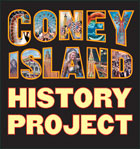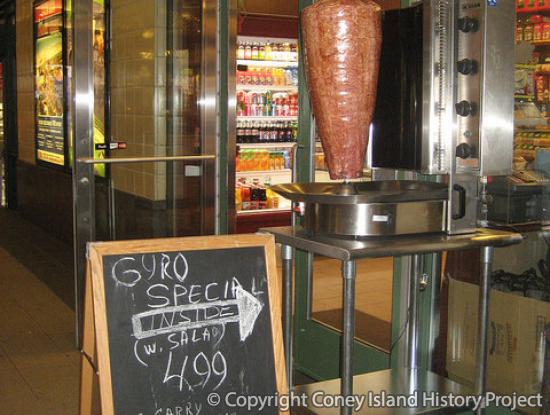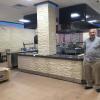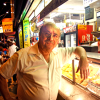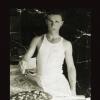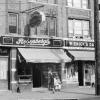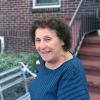Serhan Ayhan: What is your name and where were you born?
Levent Demirgil: My name is Levent Demirgil. I was born in Ankara, Turkey. Ankara’s Polat county...I’m from Ankara. Ankara, Turkey.
SA: I’m Serhan, I was born here (in the US). Actually, my mother and father are from Ankara too.
LD: Where in Ankara?
SA: I believe in Kurtuluş.
LD: I entered Ankara University for a while, but then I left.
SA: Actually, I studied abroad at Middle East Technical University in Ankara in 2007.
LD: 1980...in the 80s Turkey was very mixed up at the time. In the 80s there were many political issues at the time. Problems. So, I started school and then left to come to America.
SA: What year did you arrive here?
LD: 88. I came here in 88. I came as a student to study, but after one year I left school. After leaving school, I started to work.
SA: How did you decide to come to America?
LD: When there was difficulty attending school in Turkey...the schools were very mixed up at the time. If you were of different political opinion, you could not attend.
METU did not really allow us to study. After leaving school...I did not really want to continue life in Turkey. I grew tired of Turkey. I did not want to go to Europe...I set my mind on America, and so I came to America.
I had a friend in Long Island. My...father’s friend’s son. He had a gas station. I moved by him, I went to school for 4, 5, 6 months. I saw that completing school would take a long time.
Since I came from a family of business...well, when I saw that there were possibilities for business, I decided to go into business and started my business. Since that day, I have been in business. How many years has it been? 25, 26 years I have been dealing with business.
SA: What field did you go into at school?
LD: Electrical and electronics. Basically, engineering. But I didn’t finish.
SA: Specifically, why did you decide to move to Brooklyn and open a store in Coney Island?
LD: Actually, at first I came to Long Island. I stayed there for a while, and then I attended school in Manhattan and then once again I returned to Long Island. And so in ‘92 in Brighton Beach I opened a market. Our market is still there. Vintage Food. It’s continued as a specialty food market. After that we started wholesaling, opened another shop. In King’s Highway. That shop is still in business right now.
Where do you live?
SA: Me...I’m in Queens. Jackson Heights.
LD: In Jackson Heights they have the Indian area.
SA: Yes. Everyone is there.
LD: Indians, Pakistanis…
SA: All people. It’s like a microcosm of the world. I really like it there.
We also have a shop in Astoria called Boston Pizza. We’ve been there for about the last twenty years. Before that, my family had several restaurants called Salad Bowl. On 3rd Avenue, Lexington...Times Square, Manhattan Mall. They were everywhere. Later when we came to Astoria, we opened a pizzeria...it’s been like that for the last twenty years or so.
LD: We come from the same business. We also opened a restaurant in Manhattan with partners for a while, later the partner left and they closed. They could not really continue. It was called Kebab Garden. It was a nice restaurant. On First Avenue. St. Mark’s was right next to it. What year was it? I don’t know, four or five years ago, maybe. I left the partnership, they continued it, and then left it.
A nice restaurant. The fast food type, but the partners could not continue it after I left.
SA: The food business is hard.
LD: The restaurant business isn’t an easy business. Namely, if you yourself don’t know, if you do not have the skill...it’s hard. The same work 24 hours a day for seven days. You have to constantly keep at it.
SA: We are just the same.
LD: Later the idea of fast food business got stuck in my head. Turkish products, Mediterranean products as fast food products that we sell, how we could do it...those we thought about.
We suffered through Hurricane Sandy. Here, my shop in Brighton Beach, and then...well, between my warehouses...we closed here. Three years, four years, we couldn’t even open here. Here it was top to bottom water anyway. In fact, we have photos of here where everything was upside-down. It was so awful here.
SA: So you’ve endured many hardships because of Sandy.
LD: We suffered a lot from Sandy. Sandy...we didn’t have insurance. Without insurance, we couldn’t get help.
SA: FEMA and such?
LD: For businesses, that was helping us, SBA. Small Business Administration. FEMA gave them the commercial credit things, but those were...4% interest.
They were giving loans at 4% interest. 4% interest...a home loan was 3% interest anyway. How this was help, I didn’t understand. At 4% interest. How could this be help? I did not accept. I said we were already victims, we were victimized from Sandy. The second victimizing would be coming from you, basically. You should be giving us loans without interest, or give rebates so that it will help.
I applied to five places and all five I rejected. I do not want to do business with interest. I took personal loans. By taking those we are trying to stay afloat, that’s why we could not open here for three years.
At the warehouse nearly forty containers were trashed. Trucks, this, that, it all went. All of the fork lifts, our tools in the warehouse, all gone. The offices were completely gone.
Really, here was completely...here it all had to be trashed. We paid rent here for three, four years. Leaving here felt a little...like we were completely throwing away our investment, so we changed our minds. We will open again, hopefully, let’s see.
SA: It’s as though out here is more lively.
LD: Coney Island became lively once more. It’s better than it used to be, Coney Island. Many new businesses came. Hopefully, Luna Park is not the only step...maybe more things will come. Because of that we were hopeful, and paid the rent.
My main purpose is this. You know Chipotle. We are here to bring and set the concept of a Mediterranean Grill.
Because Turkish and Mediterranean things are what everyone knows and wants.
American healthy food concepts fit really well with Mediterranean foods.
SA: Yes, all of the olives oil foods and such.
LD: Olive oil, hummus, salads, this and that, kebabs...our doner kebabs, especially. In American healthy food concepts, it’s a new view. Hamburgers, American things, franchises...now people are tired from eating these things over and over.
SA: They want a little variety.
LD: It can be a little difference. This will be a different concept because doner right now in Europe is very big. I have spent eight years on this...doner project. Eight years. I travelled to Europe many times. I know all of the doner shop owners in Turkey. There is a doner convention every year, I go there.
SA: Doner convention?
LD: Of course, they have a doner convention.
SA: Is that so?
LD: Of course, it happens every year in Turkey. They gather all of the doner shop owners of the world in Turkey. I’ve done a lot of research. For doner to catch on in America...I mean, in Europe they sell them everywhere, night and day.
It’s a great fast food item. Healthy, as in you do not fry it. Because it is healthy, and the fats drip as you cut it...it’s a very healthy thing. In terms of fast food, that is.
Europeans...I mean, from Turks, it’s become a quintessential European entity.
There’s no reason why this can’t happen in America. However, not with individual locations, but rather the concept of franchises.
SA: Something like Chipotle.
LD: Chipotle is another story. Namely, Mexican Grill.
Doner shops in Europe mainly sell doner. They don’t sell anything else. But I want doner plus Mediterranean grill.
Meaning hummus, rice, salad, babaganoush. Turkish and Mediterranean meze varieties.
Standard is very important. Our intention...we think very big. I mean, we’ve stuck to the idea of making a franchise.
We are going to start with a robot. A doner cutting robot. This has really caught on in Europe right now. They don’t have this in America right now.
SA: What do your customers think about your Turkish food?
With regard to Mediterranean grill and doner, there isn’t anyone who does not want anyhow. Everyone likes it if it’s good quality.
SA: So your customers are what type of people? Turks or different folks from around here?
LD: My target demographic is everyone. I mean they can be Turks, they can be anyone, the business model was created based on that idea. Americans, Turks, Latinos, everyone.
SA: What types of people come to your other shops?
LD: Those are markets. Those are a mixed crowd. We sell more specialty foods there. Like our Turkish goods. Nuts, fruits, dried fruit. Olive oil, olives. dairy. We have our brand, Merve.
SA: I really like that. They’re cheeses and such.
LD: That’s our brand.
SA: Aha.
LD: Yes, yes.
SA: Do you live in South Brooklyn around here or somewhere else?
LD: I live in Manhattan Beach. The kids’ schools are around there. I’ve got seven kids.
SA: Seven kids!
LD: Yup. Five girls, two boys. Seven kids. The youngest is two, three years old. Hasn’t started school or anything yet.
SD: And how old are you?
LD : 53.
SA: Is your family in the same business like yourself, or?...
LD: Well, my family in Turkey does business. Our family has always been business. Business.
I mean I have a doctor sibling, I have other siblings. In every trade, at the moment. My grandfather did business in Turkey...agriculture. He had a farm, previously.
I did not think about becoming an engineer.
SA: Your journey from Turkey…
LD: To here? In 88...Delta...well, Pan-Am. It was around back then. It was a connecting flight. There were no direct flights from Turkey back then. That started later. With Pan-Am, I landed in Frankfurt, and from Frankfurt I connected and came to America.
SA: Did you go from Ankara to Istanbul?
LD: I went to Istanbul from Ankara with Train. My first trip was like that.
SA: Did you come alone?
LD: I came all by myself. It was an adventure. It was really an adventure, in the end. A new world, new people, you don’t know anyone.
SA: What did you think about Coney Island when you first saw it?
LD: Well, Coney Island, it’s like this...back then it was calm around here. It was not this crowded. Coney Island now has really started to become lively.
SA: In the 80s and such.
LD: Of course, 88, the 90s, 95 and so...Coney Island was calm. There was not that much. There was the Coney Island Cyclone. Around there they had very simple things. I mean, it was not as nice as it is now. But now it has really started to become lively.
SA: Which was your first gourmet food store? How did you start with one and end up with four? How did you come to open Coney Island Gourmet at Stillwell Terminal?
LD: My first place was in Brighton Beach. After that, my second place was at 86th. Then we opened our third place on Kings Highway.
Actually...we opened here as a market, it was not fast food. A market just did not work here. I mean a market could not make business here. After that, we turned it around, changed the idea, and decided to make fast food here.
But here is a seasonal place. During the winter you won’t see anyone here for five months. Unfortunately we’ve missed the season. Let’s see what we’re going to do this winter.
SA: Is it cold here in the winter?
LD: Because of the cold there aren’t any people. No tourists. Tourists are Coney Island’s big thing. It will start in April and until October you’ve got serious tourists here.
Just like how in winter in Manhattan and Broadway they go to the theater, there needs to be something like that here. Theaters. Casinos. Coney Island, I mean twelve months of the year needs to be like Times Square. Not just summer, twelve months of the year there needs to be hotels. They need to make luxury hotels here. If you have nice hotels...it’s really easy to get to Manhattan.
Great things can be made here. You can bring the Atlantic City thing here. An entertainment center. It was like that here back in the day. When you look at the old photos, there were places like that, there are photos like that. Together with American history this place has changed. It has all changed. Repeatedly started all over again.
Our goal is something like that. Nathan’s has been here for quite a while, a hundred years...I mean in history we can be the first doner franchise and can start with its location here.
I mean, if you want to be a brand...Nathan’s.
SA: The hot dog place.
LD: The first place was right there. They started here. I mean, to familiarize people, for a location to be here is very important.
Since we came here our goal has been to create something great. Our intention is that, if we can create something great…It’s not about profits. If you can create and bring about great things...whatever you can think of will follow.
If you go in with the intention of making money, people start to go down the wrong paths.
If you do something for money, you’ll do anything. Our goal has not been to make money. I mean if you do something to make money, they will not bring you anywhere.
But it’s not money, money...The money issue is this. To create great things. To open a path, to be a leader. I mean to be a leader in a field. We introduced Turkish goods to people. You’ve gotta look at the big picture.
SA: What do you think of the Turks in this neighborhood?
LD: There are two types of Turks here. The first type of Turk is the one that gets his salary, and right away without making an investment wants to retire.
They can be someone already settled here, or they can be second generation. They don’t think much about business. They finish school, start a career, and then they work. They lose the entrepreneurial spirit. But the thought process of many is this, they see that since mom and dad work a lot, they do not want to do the work of their parents.
I mean, come home late, wake up early. Many hardships, difficulties...because of that they all study. The second generation studies more.
And so daddy can’t go home. Some days dad can’t go eat. On some days the kids eat, go to bed, and I come home late, and because of that kids will look at their parents’ work and will not quite warm up to it.
I mean, they all complete school and you’ve got engineers, doctors, dentists. Whatever field they choose, they do it and it’s much more regimented.
Our life is work night and day.
One type of Turk is like that. Work fourty hour weeks. They get their salary, see their kids, have a social life.
And one group has lost everything. They spend as they get, living day to day. They’ve kind of lost hope, there are Turks like that too, unfortunately.
SA: Have they lost part of their culture?
LD: They’ve lost part of their culture, instead of partaking in the good parts of America they’ve gone into the bad. The night life. drugs. So there are Turks like that, but not a whole lot.
And then you have Turks who do business. Continually trying to do business.
In general, the Turks are not bad. Turkish society is not too bad.
SA: When did you last go to Turkey?
LD: Last year. I went before then but, now I just go for business.
SA: To Ankara?
LD: More to Istanbul. I don’t go to Ankara much because we do not have anyone there. Izmir, Istanbul, Bursa. Gaziantep, Konya.
It’s like that for vacation. Since we do not go much on vacation. For holidays, for example, I’m here 26, 27 years and if you think of 54 holidays...1 holiday spent in Turkey I was able to spend in Turkey, and 53 in America.
I mention holidays in Turkey, but my mom in Turkey is in Ankara, Istanbul. They travel. I have a brother in Istanbul, they go to him.
SA: Do you have any other thoughts on Coney Island history or anything else?
LD: At our old location, our old place we had a thing...all of Coney Island’s history. I mean since the beginning in the 1920s...2000s, until 2015 I had gathered all of the photos and here we had a monitor and those pictures would be in a slideshow on that big monitor. Beautiful photos.
SD: Meaning, you know Coney Island’s history very well.
LD: I know Coney Island’s history very well. It has changed many times. Now, to get to its current state, it has changed maybe twenty times. Coney Island is a really interesting place. I think Coney Island is a place that has endured every point in American history. Everything that America has endured up until this day, in every era, it has experienced something different. I mean there is serious history here.
Sixty years ago, whatever crowds Coney Island had is now the same. Now it has started to come back. For example I have photos of this area to the right...if you dropped a pin you would not be able to drop it in between the crowds. That’s how crowded it was. In the 1930s, maybe 20s.
I mean Coney Island is really not just New York’s but perhaps America’s oldest and continuous popular location.
Coney Island is truly a brand. Because of that if they seriously promote and advertise they can bring back its previous form. It can be the world’s center.
If I had pictures I could show you. We have it on a floppy disk. If you saw the pictures you would be surprised.
SA: Will you show those photos again at this new shop?
LD: We are not thinking of that right now. I mean right now...maybe we will have a monitor.
I mean we you see the previous form of Coney Island, I mean you have to think differently about where you are. I did not know that form of Coney Island. Coney Island is truly a surprising place.
SA: Mr. Demirgil, thank you so much for your time and stories.
LD: Thank you.
